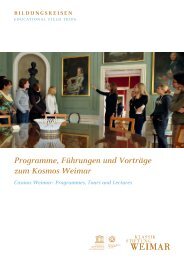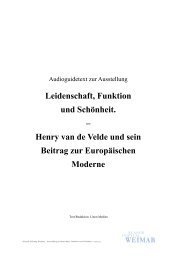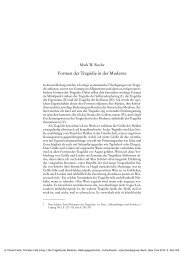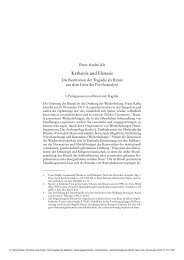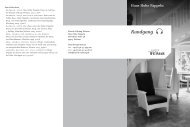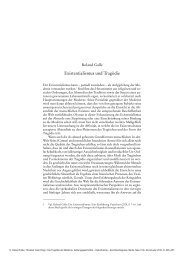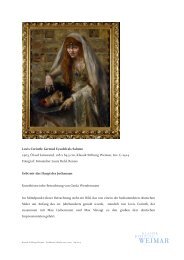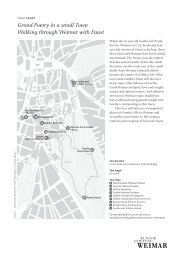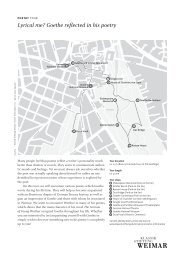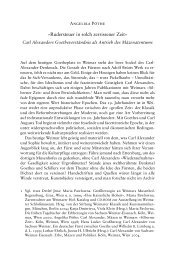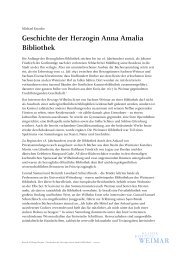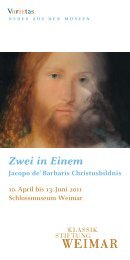Passion, Function and Beauty. â Henry van de Velde and his ...
Passion, Function and Beauty. â Henry van de Velde and his ...
Passion, Function and Beauty. â Henry van de Velde and his ...
You also want an ePaper? Increase the reach of your titles
YUMPU automatically turns print PDFs into web optimized ePapers that Google loves.
Audio Gui<strong>de</strong> to the exhibition<br />
<strong>Passion</strong>, <strong>Function</strong> <strong>and</strong> <strong>Beauty</strong>.<br />
–<br />
<strong>Henry</strong> <strong>van</strong> <strong>de</strong> Vel<strong>de</strong> <strong>and</strong> <strong>his</strong><br />
Contribution to European<br />
Mo<strong>de</strong>rnism<br />
Editing: Linon Medien<br />
Klassik Stiftung Weimar | Exhibition <strong>Passion</strong>, <strong>Function</strong> <strong>and</strong> <strong>Beauty</strong> | 03.2013<br />
1
Content<br />
701: <strong>Henry</strong> <strong>van</strong> <strong>de</strong> Vel<strong>de</strong>: Six-arm C<strong>and</strong>elabra ......................................................................... 3<br />
702: <strong>Henry</strong> <strong>van</strong> <strong>de</strong> Vel<strong>de</strong>: Faits du village VII, La fille qui remaille (Girl sewing) (1890)....... 4<br />
703: Victor Horta: Elements from the Turin Ensemble (1902).................................................. 5<br />
704: <strong>Henry</strong> <strong>van</strong> <strong>de</strong> Vel<strong>de</strong>: Belt Buckle for Gertrud Osthaus (1898/99) ..................................... 6<br />
705: <strong>Henry</strong> <strong>van</strong> <strong>de</strong> Vel<strong>de</strong>: Abstract Plant Composition (1893).................................................. 7<br />
706: <strong>Henry</strong> <strong>van</strong> <strong>de</strong> Vel<strong>de</strong>: Blue Tea Gown with wi<strong>de</strong>, <strong>de</strong>corative bor<strong>de</strong>r (um 1896) ............... 8<br />
707: <strong>Henry</strong> <strong>van</strong> <strong>de</strong> Vel<strong>de</strong>: Bloemenwerf Dining Table (1895) .................................................. 10<br />
708: <strong>Henry</strong> <strong>van</strong> <strong>de</strong> Vel<strong>de</strong>: Barber’s workstation for the François Haby Barber Salon ............. 11<br />
709: <strong>Henry</strong> <strong>van</strong> <strong>de</strong> Vel<strong>de</strong>: Tropon Advertising Poster (1897/98) ............................................. 12<br />
710: Gustave Serrurier-Bovy: Silex Armchair (1905) ............................................................... 13<br />
Josef Hoffmann: Sitzmaschine (1908)<br />
711: <strong>Henry</strong> <strong>van</strong> <strong>de</strong> Vel<strong>de</strong>: Writing Desk for the Publisher Ludwig Löffler (1898) ................... 14<br />
712: Erica von Scheel: Stu<strong>de</strong>nt’s Work: Vinegar <strong>and</strong> Oil Bottles (1903).................................. 15<br />
713: <strong>Henry</strong> <strong>van</strong> <strong>de</strong> Vel<strong>de</strong>: Dinner Service for 10 people (1903/04)........................................... 16<br />
714: Johanna Brinkhaus: Wax Batik on Silk.............................................................................. 17<br />
715: <strong>Henry</strong> <strong>van</strong> <strong>de</strong> Vel<strong>de</strong>: Wax Batik on Silk (1905) ................................................................ 18<br />
716: Georg Kolbe: Portrait of Harry Graf Kessler (1916) ......................................................... 19<br />
717: <strong>Henry</strong> <strong>van</strong> <strong>de</strong> Vel<strong>de</strong>: Wicker Chair (1908) ....................................................................... 20<br />
718: <strong>Henry</strong> <strong>van</strong> <strong>de</strong> Vel<strong>de</strong>: Nursery Table (1911)....................................................................... 21<br />
719: <strong>Henry</strong> <strong>van</strong> <strong>de</strong> Vel<strong>de</strong>: Draft Design for the Director’s Room (1908).................................. 22<br />
720: <strong>Henry</strong> <strong>van</strong> <strong>de</strong> Vel<strong>de</strong>: Home Hohe Pappeln (Mo<strong>de</strong>l).......................................................... 23<br />
721: <strong>Henry</strong> <strong>van</strong> <strong>de</strong> Vel<strong>de</strong>: Dumont Theatre Draft Design (1904), Werkbund Theatre ............. 24<br />
722: <strong>Henry</strong> <strong>van</strong> <strong>de</strong> Vel<strong>de</strong>: Draft Drawing of the Nietzsche Monument (1912) ........................ 25<br />
723: Ernst Ludwig Kirchner: “Head of <strong>van</strong> <strong>de</strong> Vel<strong>de</strong> (light)” (1917)........................................ 26<br />
724: <strong>Henry</strong> <strong>van</strong> <strong>de</strong> Vel<strong>de</strong>: Kettle with réchaud (1922-1925) ..................................................... 27<br />
725: Mo<strong>de</strong>l of the ‘Prince Baudouin’ mail steamer (1934)........................................................ 28<br />
726: Max Elskamp: Salutations, dont d’angé (1893)................................................................. 29<br />
727: Friedrich Nietzsche: Also sprach Zarathustra (Thus Spoke Zarathustra) (1908)............... 30<br />
728: Desk with book cases, UB Ghent (from 1920) .................................................................. 31<br />
729: Oscar Jespers: Portrait of <strong>Henry</strong> <strong>van</strong> <strong>de</strong> Vel<strong>de</strong> (c. 1930) ................................................... 32<br />
Klassik Stiftung Weimar | Exhibition <strong>Passion</strong>, <strong>Function</strong> <strong>and</strong> <strong>Beauty</strong> | 03.2013<br />
2
701: <strong>Henry</strong> <strong>van</strong> <strong>de</strong> Vel<strong>de</strong>: Six-arm C<strong>and</strong>elabra<br />
<strong>Henry</strong> <strong>van</strong> <strong>de</strong> Vel<strong>de</strong>: Six-arm C<strong>and</strong>elabra (1898/99)<br />
T<strong>his</strong> major exhibition of outst<strong>and</strong>ing works<br />
by <strong>Henry</strong> <strong>van</strong> <strong>de</strong> Vel<strong>de</strong> presents the spectrum<br />
of <strong>his</strong> artistic activity – from 1890 to<br />
the end of the 1930s.<br />
Van <strong>de</strong> Vel<strong>de</strong>’s most productive period<br />
was probably between 1902 <strong>and</strong> 1917<br />
when he was here in Weimar as the advisor<br />
for Thuringian artisans <strong>and</strong> craft industries,<br />
<strong>and</strong> was Director of the School of Arts <strong>and</strong><br />
Crafts.<br />
Our exhibition shows that Van <strong>de</strong> Vel<strong>de</strong><br />
was a multi-talented artist whose <strong>de</strong>signs<br />
embraced all areas of life, from houses to<br />
furniture, clothing, jewellery <strong>and</strong> lamps –<br />
<strong>and</strong> even the interior furnishings for a series<br />
of large steamers. <strong>Henry</strong> <strong>van</strong> <strong>de</strong> Vel<strong>de</strong><br />
had a vision of transforming people’s surroundings<br />
into a Gesamtkunstwerk - a synthesis<br />
of the arts – where every artistic <strong>de</strong>-<br />
Welcome to t<strong>his</strong> major exhibition entitled:<br />
‘<strong>Passion</strong>, <strong>Function</strong> <strong>and</strong> <strong>Beauty</strong>. <strong>Henry</strong> <strong>van</strong><br />
<strong>de</strong> Vel<strong>de</strong> <strong>and</strong> <strong>his</strong> Contribution to European<br />
Mo<strong>de</strong>rnism’!<br />
T<strong>his</strong> six-arm c<strong>and</strong>elabra, our first exhibit<br />
on t<strong>his</strong> tour, dates from the late 1890s. It<br />
already combines many elements characteristic<br />
of Van <strong>de</strong> Vel<strong>de</strong>’s work, especially<br />
<strong>his</strong> love for dynamic lines <strong>and</strong> curves. The<br />
c<strong>and</strong>elabra’s <strong>de</strong>sign is nearly entirely<br />
structured around dynamic lines. In some<br />
elements, these lines flow smoothly, while<br />
in others they create striking curves away<br />
from <strong>and</strong> towards the centre. Yet, in t<strong>his</strong><br />
process, the individual form is perfectly<br />
fused with the object’s function. In Van <strong>de</strong><br />
Vel<strong>de</strong>’s view, the perfection of an object’s<br />
<strong>de</strong>sign is directly linked to how well the<br />
object fulfils its purpose.<br />
(short pause)<br />
Klassik Stiftung Weimar | Exhibition <strong>Passion</strong>, <strong>Function</strong> <strong>and</strong> <strong>Beauty</strong> | 03.2013<br />
3
702: <strong>Henry</strong> <strong>van</strong> <strong>de</strong> Vel<strong>de</strong>: Faits du village VII, La fille qui remaille<br />
(Girl sewing) (1890)<br />
<strong>Henry</strong> <strong>van</strong> <strong>de</strong> Vel<strong>de</strong>: Faits du village VII, La fille<br />
qui remaille (Girl sewing) (1890)<br />
The young girl is portrayed calmly concentrating<br />
on her work. It is a sunny day;<br />
the light through the trees casts an oddlyshaped<br />
shadow on the grass. Behind the<br />
girl, we can see a path <strong>and</strong> a large building.<br />
T<strong>his</strong> work belongs to <strong>van</strong> <strong>de</strong> Vel<strong>de</strong>’s<br />
Faits du village series comprising various<br />
scenes from village life, <strong>and</strong> dates<br />
from 1890. To create t<strong>his</strong> image, he employed<br />
the pointillist technique of painstakingly<br />
juxtaposing dabs of pure colour<br />
onto the picture’s support. Pointillism is<br />
most closely associated with the French<br />
painter George Seurat. Van <strong>de</strong> Vel<strong>de</strong> had<br />
discovered the technique several years<br />
before in Seurat’s works, <strong>and</strong> was<br />
thrilled by its possibilities.<br />
Pointillism does not mix colours on a<br />
palette <strong>and</strong> then apply them, but sets dots<br />
or short brushstrokes of pure colour close<br />
to one another. The colours are then only<br />
combined to create an image in the eye<br />
of the behol<strong>de</strong>r.<br />
When he was 17, <strong>Henry</strong> <strong>van</strong> <strong>de</strong> Vel<strong>de</strong><br />
started <strong>his</strong> classical art training at the<br />
Fine Arts Aca<strong>de</strong>my in Antwerp – <strong>de</strong>spite<br />
the disapproval of <strong>his</strong> parents, who wanted<br />
him to go into a solid middle-class administrative<br />
career.<br />
As you can see, <strong>Henry</strong> <strong>van</strong> <strong>de</strong>r Vel<strong>de</strong> was a<br />
virtuoso painter. He spent time in Paris a<br />
number of times to explore the works of<br />
the Impressionist painters, <strong>and</strong> painted in a<br />
pointillist style for some years until, in<br />
1890, he saw works by Vincent <strong>van</strong> Gogh.<br />
Deeply impressed, he then sought to portray<br />
the flow of life through an emotive <strong>and</strong><br />
dynamic use of line.<br />
Klassik Stiftung Weimar | Exhibition <strong>Passion</strong>, <strong>Function</strong> <strong>and</strong> <strong>Beauty</strong> | 03.2013<br />
4
703: Victor Horta: Elements from the Turin Ensemble (1902)<br />
The houses that Horta <strong>de</strong>signed became<br />
milestones in art nouveau in Belgium.<br />
In <strong>van</strong> <strong>de</strong> Vel<strong>de</strong>’s view, Horta was only a<br />
‘mediocre architect’. Above all, he disliked<br />
the overloa<strong>de</strong>d, functionless ornamental<br />
elements which Horta used to <strong>de</strong>corate <strong>his</strong><br />
buildings. A good example here is the Socialist<br />
Party headquarters in Brussels with<br />
a faça<strong>de</strong> entirely in glass <strong>and</strong> steel – as you<br />
can see in the photo on the wall. In <strong>his</strong><br />
memoirs, <strong>van</strong> <strong>de</strong> Vel<strong>de</strong> noted:<br />
Victor Horta: Elements from the Turin Ensemble<br />
(1902)<br />
In 1902, one of the seminal events in popularising<br />
art nouveau took place – the International<br />
Exhibition of Mo<strong>de</strong>rn Decorative<br />
Arts in Turin, an exhibition exclusively<br />
<strong>de</strong>dicated to <strong>de</strong>sign.<br />
The objects on show there inclu<strong>de</strong>d t<strong>his</strong><br />
couch table <strong>and</strong> chair created by the Belgian<br />
architect <strong>and</strong> <strong>de</strong>signer Victor Horta.<br />
Born in 1861, Horta was one of the first<br />
architects on the European mainl<strong>and</strong> to<br />
reject the <strong>his</strong>torical-revivalist styles so<br />
prevalent in the second half of the nineteenth<br />
century.<br />
Even in the early 1890s, Horta began transferring<br />
art nouveau <strong>de</strong>signs to architecture.<br />
Previously, the new direction taken by art<br />
nouveau – or Jugendstil, as it is known in<br />
Germany – was primarily applied to craft<br />
products.<br />
Victor Horta: Elements from the Turin Ensemble<br />
(1902)<br />
“Horta’s exaggerations are inten<strong>de</strong>d to<br />
beautify the rational metal constructions,<br />
but are annoying for their pointlessness <strong>and</strong><br />
unbridled fantasy.”<br />
Klassik Stiftung Weimar | Exhibition <strong>Passion</strong>, <strong>Function</strong> <strong>and</strong> <strong>Beauty</strong> | 03.2013<br />
5
704: <strong>Henry</strong> <strong>van</strong> <strong>de</strong> Vel<strong>de</strong>: Belt Buckle for Gertrud Osthaus<br />
(1898/99)<br />
Van <strong>de</strong> Vel<strong>de</strong> carried out <strong>his</strong> first experiments<br />
in abstract ornamentation on twodimensional<br />
images, for example, as book<br />
<strong>de</strong>signs or advertising posters. But shortly<br />
before 1900, he also started to apply <strong>his</strong><br />
structures of dynamic lines to craft work –<br />
as is evi<strong>de</strong>nt, for example, in <strong>his</strong> <strong>de</strong>sign for<br />
t<strong>his</strong> belt buckle.<br />
<strong>Henry</strong> <strong>van</strong> <strong>de</strong> Vel<strong>de</strong>: Belt Buckle for Gertrud Osthaus<br />
(1898/99)<br />
Van <strong>de</strong> Vel<strong>de</strong> <strong>de</strong>signed t<strong>his</strong> silver belt<br />
buckle in the late 1890s. The buckle resembles<br />
a relief of dynamic sinuous lines.<br />
From early on in <strong>his</strong> artistic career, <strong>van</strong> <strong>de</strong><br />
Vel<strong>de</strong> had been fascinated by linearity –<br />
for example, as found in nature. In <strong>his</strong><br />
memoirs, he recalls how in 1890, when he<br />
was staying on the North Sea coast, he often<br />
went down the beach: “(...) to sketch<br />
the linear arabesques left by the receding<br />
waves in the s<strong>and</strong>. Earlier, I had already<br />
been fascinated by similar shapes in the<br />
dunes: (...) sop<strong>his</strong>ticated abstract <strong>de</strong>corations<br />
drawn by wind in the s<strong>and</strong>.”<br />
Later, <strong>van</strong> <strong>de</strong> Vel<strong>de</strong> also addressed the theory<br />
of the line <strong>and</strong> its laws of movement.<br />
Through <strong>his</strong> use of dynamic lines, he<br />
hoped to <strong>de</strong>velop <strong>de</strong>corative elements that<br />
were no longer figural, but purely abstract.<br />
In an essay written in 1901, he noted: “(...)<br />
it was the thought that lines st<strong>and</strong> in an<br />
equally logical <strong>and</strong> consistent relationship<br />
with each other as numbers <strong>and</strong> notes in<br />
music which led me to search for a purely<br />
abstract <strong>de</strong>corative art which <strong>de</strong>rives its<br />
beauty from itself (...).”<br />
Klassik Stiftung Weimar | Exhibition <strong>Passion</strong>, <strong>Function</strong> <strong>and</strong> <strong>Beauty</strong> | 03.2013<br />
6
705: <strong>Henry</strong> Van <strong>de</strong> Vel<strong>de</strong>: Abstract Plant Composition (1893)<br />
Elsewhere, he <strong>de</strong>scribes how <strong>his</strong> abstract<br />
use of line was inspired by nature, <strong>and</strong> not<br />
just by Van Gogh.<br />
But what was it that led <strong>Henry</strong> <strong>van</strong> <strong>de</strong><br />
Vel<strong>de</strong> to give up painting altogether? To<br />
find out, just key in 1.<br />
<strong>Henry</strong> Van <strong>de</strong> Vel<strong>de</strong>: Abstract Plant Composition<br />
(1893)<br />
Is t<strong>his</strong> a plant? Or an abstract image – perhaps<br />
a line study? It is hard to say – <strong>and</strong><br />
only the pumpkin in the lower right h<strong>and</strong><br />
corner can actually be i<strong>de</strong>ntified as a plant<br />
with any certainty.<br />
T<strong>his</strong> pastel, painted in 1893, is a key work<br />
in <strong>van</strong> <strong>de</strong> Vel<strong>de</strong>’s œuvre. It clearly reflects<br />
<strong>his</strong> move away from painting <strong>and</strong> sketching<br />
towards artistic works with a universal<br />
message – <strong>and</strong>, moreover, to entirely structuring<br />
<strong>his</strong> works through dynamic linearity<br />
<strong>and</strong> <strong>de</strong>corative elements. After painting in<br />
an Impressionist or neo-impressionist style<br />
for many years, <strong>van</strong> <strong>de</strong> Vel<strong>de</strong> adopted an<br />
increasingly abstract style. In t<strong>his</strong> <strong>de</strong>velopment,<br />
he was primarily interested in linearity.<br />
The fascination with the power of lines<br />
remained with him throughout <strong>his</strong> life <strong>and</strong><br />
was a major influence on <strong>his</strong> work. He<br />
wrote about t<strong>his</strong> fascination in <strong>his</strong> memoirs:<br />
“Even after I had ab<strong>and</strong>oned painting,<br />
the <strong>de</strong>mon of lines has not left me <strong>and</strong><br />
when I was creating the first ornaments,<br />
they came into being out of a dynamic interplay<br />
of their elementary forces.“<br />
Second level:<br />
After the early <strong>de</strong>ath of <strong>his</strong> mother in<br />
1888, <strong>Henry</strong> <strong>van</strong> <strong>de</strong> Vel<strong>de</strong> withdrew into<br />
himself. He started to read philosophy intensively<br />
including, for example, the<br />
works of Friedrich Nietzsche.<br />
He was also influenced by the writings of<br />
John Ruskin <strong>and</strong> William Morris, the initiators<br />
of the English Arts <strong>and</strong> Crafts Movement,<br />
who criticised industrial mass production.<br />
Since, in their view, aesthetic <strong>de</strong>sign<br />
in industrial production was constantly<br />
<strong>de</strong>gra<strong>de</strong>d, both Ruskin <strong>and</strong> Morris<br />
called for a radical shift to create everyday<br />
objects from the best materials in solid,<br />
craft quality, <strong>and</strong> with clear <strong>de</strong>signs.<br />
William Morris in particular regar<strong>de</strong>d a<br />
return to craftwork as one element in an<br />
overall artistic <strong>and</strong> social reform which<br />
would also upgra<strong>de</strong> the status of craftwork<br />
in relation to the ‘high arts’. His credo was<br />
that high quality art <strong>and</strong> craftwork could<br />
positively influence both individuals <strong>and</strong><br />
everyday life.<br />
Van <strong>de</strong> Vel<strong>de</strong> was particularly impressed<br />
by Morris' i<strong>de</strong>a of art having a <strong>de</strong>cisive<br />
role to play, especially in an industrial <strong>and</strong><br />
technical society. Yet these i<strong>de</strong>as also led<br />
to an existential crisis. Van <strong>de</strong> Vel<strong>de</strong> came<br />
to believe that painting was no longer an<br />
a<strong>de</strong>quate means of expression.<br />
In the end, from 1893, he turned to the applied<br />
arts, <strong>and</strong> later to architecture.<br />
T<strong>his</strong> abstract study of plants was one of <strong>his</strong><br />
last paintings.<br />
Klassik Stiftung Weimar | Exhibition <strong>Passion</strong>, <strong>Function</strong> <strong>and</strong> <strong>Beauty</strong> | 03.2013<br />
7
706: <strong>Henry</strong> <strong>van</strong> <strong>de</strong> Vel<strong>de</strong>: Blue Tea Gown with wi<strong>de</strong>, <strong>de</strong>corative<br />
bor<strong>de</strong>r (c. 1896, replica 1964)<br />
<strong>Henry</strong> <strong>van</strong> <strong>de</strong> Vel<strong>de</strong>: Blue Tea Gown with wi<strong>de</strong>,<br />
<strong>de</strong>corative bor<strong>de</strong>r (c. 1896, replica 1964)<br />
Just imagine how a woman of polite society<br />
was dressed at the end of the 19th century.<br />
Her waist laced into a tight corset, she<br />
wore ample layers of heavy petticoats un<strong>de</strong>r<br />
an hourglass-shaped gown lavishly<br />
<strong>de</strong>corated with lace <strong>and</strong> ornaments. In<br />
comparison, the blue tea gown on display<br />
here is radically different. T<strong>his</strong> wi<strong>de</strong> gown<br />
falls straight to the floor, was comfortable<br />
to wear <strong>and</strong> adapted easily to the movements<br />
of the wearer’s body – <strong>and</strong> allowed<br />
her to breathe freely. And what a relief that<br />
must have been!<br />
Around 1900, the fashionable restrictive,<br />
corseted gowns were criticised by physicians,<br />
social reformers <strong>and</strong> women’s rights<br />
campaigners, who all advocated a ‘reform<br />
dress’, which were essentially flowing, uncorseted<br />
gowns. Artists like <strong>Henry</strong> <strong>van</strong> <strong>de</strong><br />
Vel<strong>de</strong> felt called on to <strong>de</strong>sign mo<strong>de</strong>rn<br />
‘healthy’ women’s clothing able to meet<br />
high aesthetic st<strong>and</strong>ards as well.<br />
T<strong>his</strong> is a replica of <strong>his</strong> Tea Gown – a<br />
dress to be worn for afternoon tea at<br />
home.<br />
As you may have already noticed, the <strong>de</strong>sign<br />
is again clearly in<strong>de</strong>bted to <strong>van</strong> <strong>de</strong><br />
Vel<strong>de</strong>’s principle of linearity – evi<strong>de</strong>nt,<br />
for example, in the <strong>de</strong>corative bor<strong>de</strong>rs.<br />
The seams are accentuated to make the<br />
structure of the dress visible. The wi<strong>de</strong> cut<br />
allows a recognisable shape without unduly<br />
emphasising the female form – <strong>and</strong><br />
was inten<strong>de</strong>d to pave the way for mo<strong>de</strong>rn<br />
yet timeless women’s clothing <strong>de</strong>corated<br />
with abstract <strong>and</strong> linear elements.<br />
But <strong>van</strong> <strong>de</strong> Vel<strong>de</strong>’s vision of <strong>his</strong> aesthetic<br />
reform gown replacing Parisian fashion<br />
never became a reality. Not only were <strong>his</strong><br />
aesthetic st<strong>and</strong>ards too high, but the elaborate<br />
gown was too expensive to produce<br />
as a h<strong>and</strong>ma<strong>de</strong> item. In the end, <strong>van</strong> <strong>de</strong><br />
Vel<strong>de</strong>’s dress <strong>de</strong>signs were mainly worn<br />
by <strong>his</strong> wife, Maria Sèthe. She was also an<br />
artist, <strong>and</strong> played an important part in <strong>van</strong><br />
<strong>de</strong> Vel<strong>de</strong>’s work.<br />
Find out more about Maria Sèthe by keying<br />
in 2.<br />
Klassik Stiftung Weimar | Exhibition <strong>Passion</strong>, <strong>Function</strong> <strong>and</strong> <strong>Beauty</strong> | 03.2013<br />
8
2: Maria Séthe<br />
Second level:<br />
Maria Sèthe not only wore the dresses <strong>de</strong>signed<br />
by her husb<strong>and</strong>, but also largely<br />
ma<strong>de</strong> them herself. Maria was her husb<strong>and</strong>’s<br />
invaluable supporter <strong>and</strong> helper.<br />
Just like him, she too gave consi<strong>de</strong>rable<br />
thought to the reform of women’s clothing.<br />
Moreover, she was an artist in her own<br />
right, creating, for example, embroi<strong>de</strong>ries<br />
as a cottage industry.<br />
Maria Sèthe’s father was a Dutch textile<br />
manufacturer <strong>and</strong> her mother a German<br />
musician. Her family was well-off <strong>and</strong> took<br />
a keen interest in all things cultural. She<br />
grew up in in Paris <strong>and</strong> Brussels, studying<br />
painting with the Flemish neoimpressionist<br />
Théo <strong>van</strong> Rysselberghe, who<br />
introduced her to <strong>Henry</strong>.<br />
In 1893, they spent a holiday together in<br />
the Dutch countrysi<strong>de</strong> with some fellow<br />
artists. Maria <strong>and</strong> <strong>Henry</strong> fell in love, <strong>and</strong><br />
she encouraged him to give up painting <strong>and</strong><br />
<strong>de</strong>dicate <strong>his</strong> energies to the applied arts.<br />
During her time spent as a stu<strong>de</strong>nt in London,<br />
she had also come into contact with<br />
the Arts <strong>and</strong> Crafts movement there <strong>and</strong><br />
enthusiastically supported their programme<br />
for reform.<br />
From then on, Maria <strong>and</strong> <strong>Henry</strong> <strong>van</strong> <strong>de</strong><br />
Vel<strong>de</strong> were united in pursuing the i<strong>de</strong>a of<br />
driving forwards a similar arts <strong>and</strong> crafts<br />
reform movement in Belgian, <strong>and</strong> later in<br />
Germany.<br />
Klassik Stiftung Weimar | Exhibition <strong>Passion</strong>, <strong>Function</strong> <strong>and</strong> <strong>Beauty</strong> | 03.2013<br />
9
707: <strong>Henry</strong> <strong>van</strong> <strong>de</strong> Vel<strong>de</strong>: Bloemenwerf Dining Table (1895)<br />
When German Impressionist painter Max<br />
Liebermann was looking for an architect<br />
<strong>and</strong> <strong>van</strong> <strong>de</strong> Vel<strong>de</strong>’s name was suggested,<br />
Liebermann is said to have replied:<br />
‘When I furnish my apartment, I want to<br />
have the fun with it – <strong>and</strong> not Van <strong>de</strong><br />
Vel<strong>de</strong>.”<br />
<strong>Henry</strong> <strong>van</strong> <strong>de</strong> Vel<strong>de</strong>: Bloemenwerf Dining Table<br />
In 1895, <strong>van</strong> <strong>de</strong> Vel<strong>de</strong> <strong>de</strong>signed a house<br />
known as Bloemenwerf for himself <strong>and</strong> <strong>his</strong><br />
wife Maria in Uccle, today a suburb of<br />
Brussels. He did not simply <strong>de</strong>sign the<br />
house itself, but also created the entire interior<br />
furnishings – even though he was selftaught<br />
in both of these areas.<br />
The visitors to Bloemenwerf were especially<br />
impressed by the dining table. Here, rather<br />
than including any of the usual <strong>de</strong>corative<br />
elements, <strong>van</strong> <strong>de</strong> Vel<strong>de</strong>’s <strong>de</strong>sign focused<br />
entirely on function. The table’s<br />
most exceptional feature was a slightly<br />
raised ceramic panel set into the centre.<br />
Thanks to t<strong>his</strong> ingenious addition, hot serving<br />
bowls could be placed centrally on the<br />
table. Later, the ceramic panel was replaced<br />
by a panel ma<strong>de</strong> of brass.<br />
Van <strong>de</strong> Vel<strong>de</strong>’s fascination with the unity<br />
of the arts also led him to <strong>de</strong>sign the door<br />
h<strong>and</strong>les <strong>and</strong> wallpaper in <strong>his</strong> Bloemenwerf<br />
house. T<strong>his</strong> approach reflected <strong>his</strong> view<br />
that a house was a Gesamtkunstwerk,<br />
which should, in every <strong>de</strong>tail, express the<br />
personality of its occupants. Without<br />
doubt, that i<strong>de</strong>a worked very well – but<br />
only as long as <strong>van</strong> <strong>de</strong> Vel<strong>de</strong> was building<br />
for himself.<br />
Klassik Stiftung Weimar | Exhibition <strong>Passion</strong>, <strong>Function</strong> <strong>and</strong> <strong>Beauty</strong> | 03.2013<br />
10
708: <strong>Henry</strong> <strong>van</strong> <strong>de</strong> Vel<strong>de</strong>: Barber’s workstation for the<br />
François Haby Barber Salon (c. 1901)<br />
In 1900, <strong>van</strong> <strong>de</strong> Vel<strong>de</strong> was commissioned<br />
to re<strong>de</strong>sign the elegant interior of François<br />
Haby’s barber salon in Berlin. Since Haby<br />
was barber to Emperor Wilhelm II, the<br />
work stations were ma<strong>de</strong> only of the finest<br />
materials – mahogany <strong>and</strong> green marble.<br />
But the real revolution in t<strong>his</strong> workstation<br />
is not in the materials. As is only too obvious,<br />
<strong>van</strong> <strong>de</strong> Vel<strong>de</strong> did not enclose the brass<br />
gas <strong>and</strong> water pipes un<strong>de</strong>r woo<strong>de</strong>n cladding.<br />
Instead, he left them exposed, their<br />
soft lines gracefully curving around the<br />
dark wood. In retrospect, <strong>van</strong> <strong>de</strong> Vel<strong>de</strong><br />
himself took a rather critical view of <strong>his</strong><br />
<strong>de</strong>sign, writing in <strong>his</strong> memoirs: “To make<br />
the actual purpose of the things <strong>and</strong> their<br />
shapes clear, <strong>and</strong> to show their function, I<br />
ten<strong>de</strong>d to restrict myself to skeletons, <strong>and</strong><br />
forgot to surround them with flesh. But<br />
only then does the <strong>de</strong>sign appear in its perfect<br />
form, divine as in the bodies of people<br />
<strong>and</strong> animals.”<br />
Van <strong>de</strong> Vel<strong>de</strong>’s unusual interior <strong>de</strong>sign<br />
triggered quite a <strong>de</strong>bate as soon as the<br />
salon opened. The leading German Impressionist<br />
artist Max Liebermann certainly<br />
looked down <strong>his</strong> nose at it. When he<br />
saw the exposed pipes, he is reported to<br />
have said: “You don’t wear your guts like<br />
a watch chain across your waistcoat.”<br />
<strong>Henry</strong> <strong>van</strong> <strong>de</strong> Vel<strong>de</strong>: Barber’s workstation for the<br />
François Haby Barber Salon (c. 1901)<br />
But t<strong>his</strong> did nothing to diminish Haby’s<br />
success. T<strong>his</strong> star barber did not only earn<br />
money with <strong>his</strong> salon, but also with <strong>his</strong><br />
range of men’s cosmetic products. His<br />
best-known product by far was a grooming<br />
pack for h<strong>and</strong>lebar moustaches. The<br />
pack, called Es ist erreicht – roughly ‘It is<br />
achieved’–, comprised a moustache cosmetic<br />
<strong>and</strong> moustache b<strong>and</strong> for the night.<br />
With the cosmetic application, the ends of<br />
the h<strong>and</strong>lebar moustache could be twisted<br />
upwards, as worn by Emperor Wilhelm II<br />
– <strong>and</strong> at that time, the latest craze in<br />
moustache fashion. The moustache b<strong>and</strong><br />
was worn at night to ensure the moustache<br />
kept its shape.<br />
Klassik Stiftung Weimar | Exhibition <strong>Passion</strong>, <strong>Function</strong> <strong>and</strong> <strong>Beauty</strong> | 03.2013<br />
11
709: <strong>Henry</strong> <strong>van</strong> <strong>de</strong> Vel<strong>de</strong>: Tropon Advertising Poster (1897/98)<br />
<strong>Henry</strong> <strong>van</strong> <strong>de</strong> Vel<strong>de</strong>: Tropon Advertising Poster<br />
(1897/98)<br />
Van <strong>de</strong> Vel<strong>de</strong> did not only <strong>de</strong>sign the<br />
poster for Tropon. As you can see here, he<br />
also <strong>de</strong>signed a metal box for ‘Tropon<br />
Biscuits’, <strong>and</strong> a cookery book cover.<br />
In fact, he drafted all Tropon’s packaging,<br />
labels <strong>and</strong> advertising, created a logo, laid<br />
out the company’s offices, <strong>and</strong> even <strong>de</strong>signed<br />
the company’s stationary <strong>and</strong> envelopes<br />
–– the earliest example of a<br />
‘corporate <strong>de</strong>sign’ in the mo<strong>de</strong>rn sense.<br />
In <strong>his</strong> <strong>de</strong>sign for t<strong>his</strong> poster, <strong>Henry</strong> <strong>van</strong> <strong>de</strong><br />
Vel<strong>de</strong> broke new ground. In 1898, he was<br />
one of the very first artists to <strong>de</strong>sign an advertising<br />
poster for an industrial company.<br />
Van <strong>de</strong> Vel<strong>de</strong>’s approach was revolutionary.<br />
Rather than <strong>de</strong>signing the st<strong>and</strong>ard<br />
‘speaking image’ used in advertising at that<br />
time, he combined stylised Art Nouveau<br />
lines <strong>and</strong> surfaces to create an abstract pattern.<br />
The only reference to the product is<br />
the company name at the top ‘Tropon’ <strong>and</strong><br />
the product below ‘Eiweiss Nahrung’ –<br />
protein supplement. T<strong>his</strong> nutritional supplement,<br />
produced from vegetable <strong>and</strong> animal<br />
protein, was supposed to support a<br />
healthier <strong>and</strong> more balanced diet.<br />
From the mid-19th century, the general diet<br />
changed fundamentally. While the previous<br />
staple foods had largely been cereals, pulses<br />
<strong>and</strong> potatoes, increasing prosperity led<br />
to a growth in the consumption of animal<br />
products, particularly meat.<br />
Leading nutritionists supported t<strong>his</strong> <strong>de</strong>sire<br />
for meat, claiming to have i<strong>de</strong>ntified the<br />
protein in meat as a guarantor of energy<br />
<strong>and</strong> health. As the food industry respon<strong>de</strong>d<br />
to t<strong>his</strong> surge in <strong>de</strong>m<strong>and</strong>, it also created a<br />
new sector – dietary supplements, tonics<br />
<strong>and</strong> cordials.<br />
Klassik Stiftung Weimar | Exhibition <strong>Passion</strong>, <strong>Function</strong> <strong>and</strong> <strong>Beauty</strong> | 03.2013<br />
12
710: Gustave Serrurier-Bovy: Silex Armchair (c. 1905)<br />
Further along to the right, you can also<br />
see the striking ‘Sitzmaschine’ – literally,<br />
a ‘machine for sitting’ – by Viennese <strong>de</strong>signer<br />
Josef Hoffmann. The<br />
‘Sitzmachine’ was also ma<strong>de</strong> in series<br />
production – <strong>and</strong> it is just what the name<br />
says.<br />
Thanks to the stringent geometrical<br />
shapes of the individual pieces <strong>and</strong> the<br />
adjustable back, the armchair has a<br />
strongly machine-like appearance, almost<br />
as if it could roar off at any moment.<br />
Gustave Serrurier-Bovy: Silex Armchair (c. 1905)<br />
Around 1900, <strong>Henry</strong> <strong>van</strong> <strong>de</strong> Vel<strong>de</strong> was far<br />
from being the only product <strong>de</strong>signer who<br />
rejected <strong>his</strong>torical-revivalist styles <strong>and</strong><br />
sought instead to <strong>de</strong>velop an authentic contemporary<br />
<strong>de</strong>sign.<br />
Fellow Belgian architect <strong>and</strong> gifted cabinet<br />
maker Gustave Serrurier-Bovy, for example,<br />
also wanted to entirely re-<strong>de</strong>sign people’s<br />
everyday surroundings.<br />
Serrurier-Bovy is known particularly for<br />
<strong>his</strong> Silex range of furniture – to which t<strong>his</strong><br />
armchair belongs.<br />
The Silex line was produced as early ready<br />
-to-assemble furniture in kit form. When<br />
Serrurier-Bovy unveiled <strong>his</strong> Silex series to<br />
the public in 1905, it was a revolution in<br />
the <strong>his</strong>tory of <strong>de</strong>sign – the equivalent, as it<br />
were, of inventing the principle behind<br />
IKEA furniture. And with low production<br />
costs, <strong>de</strong>sign furniture was, for the first<br />
time, affordable for more than just the<br />
wealthy classes.<br />
Klassik Stiftung Weimar | Exhibition <strong>Passion</strong>, <strong>Function</strong> <strong>and</strong> <strong>Beauty</strong> | 03.2013<br />
13
711: <strong>Henry</strong> <strong>van</strong> <strong>de</strong> Vel<strong>de</strong>: Writing Desk (1903)<br />
<strong>Henry</strong> <strong>van</strong> <strong>de</strong> Vel<strong>de</strong>: Writing Desk (1903)<br />
In 1898, Van <strong>de</strong> Vel<strong>de</strong> was invited to take<br />
part in the annual exhibition of the artists’<br />
association known as the Munich Secession.<br />
At that time, Munich was the art centre<br />
in Imperial Germany, ranked even before<br />
Berlin <strong>and</strong> Dres<strong>de</strong>n.<br />
Van <strong>de</strong> Vel<strong>de</strong> <strong>de</strong>signed an entire room at<br />
the exhibition with items including the furnishings<br />
for <strong>his</strong> ‘Study in Oak’. At the centre<br />
of the study stood the won<strong>de</strong>rful <strong>de</strong>sk<br />
you can see here – one of Van <strong>de</strong> Vel<strong>de</strong>’s<br />
best known pieces of furniture.<br />
You have no doubt already noticed its most<br />
prominent feature – its curved shape T<strong>his</strong><br />
was inten<strong>de</strong>d to reflect the natural radius of<br />
the human arm so that anyone sitting at the<br />
<strong>de</strong>sk could easily reach all the writing implements<br />
<strong>and</strong> documents.<br />
Around 1900, <strong>van</strong> <strong>de</strong> Vel<strong>de</strong> was one of a<br />
number of <strong>de</strong>signers <strong>and</strong> architects across<br />
Europe interested in revitalising the arts<br />
<strong>and</strong> crafts. They all rejected the prevalent<br />
<strong>his</strong>torical-revivalist styles, <strong>and</strong> were trying<br />
to <strong>de</strong>velop a new style reflecting the mo<strong>de</strong>rn<br />
zeitgeist. The key centres in t<strong>his</strong> aesthetic<br />
<strong>de</strong>velopment inclu<strong>de</strong>d Vienna, Munich,<br />
Darmstadt <strong>and</strong> Glasgow. In t<strong>his</strong> room<br />
you can see how differently the artists in<br />
these four centres imagined a contemporary<br />
style.<br />
Klassik Stiftung Weimar | Exhibition <strong>Passion</strong>, <strong>Function</strong> <strong>and</strong> <strong>Beauty</strong> | 03.2013<br />
14
712: Erica von Scheel: Stu<strong>de</strong>nt’s Work: Vinegar <strong>and</strong> Oil Bottles<br />
(c. 1903)<br />
Erica von Scheel: Stu<strong>de</strong>nt’s Work: Vinegar <strong>and</strong> Oil<br />
Bottles (c. 1903)<br />
These simple yet elegant containers for oil,<br />
vinegar <strong>and</strong> flour were <strong>de</strong>signed by Erica<br />
von Scheel, one of <strong>van</strong> <strong>de</strong> Vel<strong>de</strong>’s first private<br />
stu<strong>de</strong>nts in Weimar.<br />
In 1902, <strong>van</strong> <strong>de</strong> Vel<strong>de</strong> moved to Weimar<br />
when Wilhelm Ernst, Gr<strong>and</strong> Duke of Saxe-<br />
Weimar, appointed him as artistic advisor<br />
for the tra<strong>de</strong>s <strong>and</strong> industry. Van <strong>de</strong> Vel<strong>de</strong>’s<br />
remit was to support businesses in the region<br />
in all <strong>de</strong>sign issues with the aim of<br />
fostering the applied arts in Thuringia <strong>and</strong><br />
making them competitive. The Kunstgewerbliches<br />
Seminar, the Arts <strong>and</strong> Crafts<br />
Seminar, foun<strong>de</strong>d in 1902 was the first<br />
contact address for tra<strong>de</strong>s <strong>and</strong> industry<br />
where they could not only receive advice,<br />
but also mo<strong>de</strong>ls for new products.<br />
Van <strong>de</strong> Vel<strong>de</strong> was perfect for the job. He<br />
had already hea<strong>de</strong>d workshops in Brussels<br />
<strong>and</strong> Berlin, <strong>and</strong> was a pioneer of cultural<br />
renewal. In Weimar, he <strong>de</strong>liberately moved<br />
away from the traditions of the Goethe era,<br />
promoting instead a mo<strong>de</strong>rn, contemporary<br />
style. The School of Arts <strong>and</strong> Crafts, with<br />
<strong>van</strong> <strong>de</strong> Vel<strong>de</strong> at its head, was also organised<br />
in t<strong>his</strong> spirit. The School building was<br />
ready to move into in 1906, <strong>and</strong> opened<br />
officially two years later with 27 stu<strong>de</strong>nts.<br />
It was supposed to foster a new generation<br />
of talented draughtsmen <strong>and</strong> women,<br />
<strong>and</strong> mo<strong>de</strong>llers. In <strong>his</strong> memoirs, <strong>van</strong> <strong>de</strong><br />
Vel<strong>de</strong> wrote: “Stu<strong>de</strong>nts were not expected<br />
to have any knowledge of past styles. Rather<br />
than familiarising themselves with<br />
products from the past, they were trained<br />
to recognise the essentials in the <strong>de</strong>sign of<br />
a range of objects (...). From that moment,<br />
stu<strong>de</strong>nts could only turn to rational <strong>de</strong>sign<br />
as their sole resource in solving problems<br />
in construction or inventing forms <strong>and</strong><br />
<strong>de</strong>corative elements.”<br />
Erica von Scheel also atten<strong>de</strong>d the School<br />
of Arts <strong>and</strong> Crafts. In her first year there,<br />
her <strong>de</strong>signs already won awards at a number<br />
of competitions. In 1910, she moved<br />
to Paris, creating batik textiles <strong>and</strong> clothes<br />
for the famous fashion <strong>de</strong>signer Paul Poiret.<br />
Klassik Stiftung Weimar | Exhibition <strong>Passion</strong>, <strong>Function</strong> <strong>and</strong> <strong>Beauty</strong> | 03.2013<br />
15
713: <strong>Henry</strong> <strong>van</strong> <strong>de</strong> Vel<strong>de</strong>: Dinner Service for 10 people<br />
(1903/04)<br />
<strong>Henry</strong> <strong>van</strong> <strong>de</strong> Vel<strong>de</strong>: Dinner Service for 10 people<br />
(1903/04)<br />
T<strong>his</strong> is part of an extensive Meissen porcelain<br />
dinner service <strong>de</strong>signed by <strong>van</strong> <strong>de</strong><br />
Vel<strong>de</strong>.<br />
Fritz Schumacher, architect <strong>and</strong> urban<br />
planner, wrote about him: “Never before<br />
may a single individual have displayed<br />
such multi-talented production in all areas<br />
of objects for home use.”<br />
What was behind <strong>van</strong> <strong>de</strong> Vel<strong>de</strong>’s approach,<br />
though, was <strong>his</strong> i<strong>de</strong>a of making art <strong>and</strong> <strong>de</strong>sign<br />
rele<strong>van</strong>t to all spheres of daily life,<br />
from A to Z. I<strong>de</strong>ally, in <strong>his</strong> view, a house<br />
should be regar<strong>de</strong>d as a kind of inhabitable<br />
Gesamtkunstwerk – a unity of the arts,<br />
where art <strong>and</strong> life are merged <strong>and</strong> fused.<br />
Ultimately, he set out to create an aesthetic,<br />
practical <strong>and</strong> positive environment to serve<br />
the balance <strong>and</strong> harmony necessary for<br />
psychological <strong>and</strong> emotional health.<br />
It is remarkable that Van <strong>de</strong> Vel<strong>de</strong> was not<br />
an expert in all these different areas. Instead,<br />
he carried out many commissions<br />
through a process of learning by doing.<br />
Sometimes, it didn’t work out – for example,<br />
<strong>his</strong> gravy boat which dripped when the<br />
gravy was poured. But in the majority of<br />
cases <strong>his</strong> lack of expertise was an ad<strong>van</strong>tage;<br />
since he had no previous<br />
knowledge of a topic, he could approach it<br />
impartially <strong>and</strong> <strong>de</strong>velop completely new<br />
solutions.<br />
T<strong>his</strong> dinner service was produced between<br />
1903 <strong>and</strong> 1904, shortly after Van<br />
<strong>de</strong> Vel<strong>de</strong> arrived in Weimar. In the town,<br />
he was not only in <strong>de</strong>m<strong>and</strong> as a multitalented<br />
artist <strong>and</strong> teacher, but soon<br />
showed that he could also shine as a host.<br />
The evening get-togethers at <strong>van</strong> <strong>de</strong><br />
Vel<strong>de</strong>’s house often inclu<strong>de</strong>d illustrious<br />
guests, for example the Austrian writer<br />
Hugo von Hofmannsthal, or Jean Jaurès,<br />
the French Socialist lea<strong>de</strong>r <strong>and</strong> antimilitarist<br />
assassinated in 1914.<br />
<strong>Henry</strong> <strong>van</strong> <strong>de</strong> Vel<strong>de</strong>: Dinner Service for 10 people<br />
(1903/04)<br />
<strong>Henry</strong> <strong>van</strong> <strong>de</strong> Vel<strong>de</strong>: Dinner Service for 10 people<br />
(1903/04)<br />
Klassik Stiftung Weimar | Exhibition <strong>Passion</strong>, <strong>Function</strong> <strong>and</strong> <strong>Beauty</strong> | 03.2013<br />
16
714: Johanna Brinkhaus: Wax Batik on Silk<br />
For <strong>van</strong> <strong>de</strong> Vel<strong>de</strong>, the linear expressed a<br />
psychological truth. In <strong>his</strong> view, <strong>de</strong>corative<br />
lines have a logical relationship to<br />
each other, rather like numbers or musical<br />
notes.<br />
Johanna Brinkhaus’ batik works must<br />
have reflected <strong>his</strong> views, since they were<br />
awar<strong>de</strong>d a prize at an exhibition of stu<strong>de</strong>nts’<br />
works in 1913.<br />
Johanna Brinkhaus: Wax Batik on Silk<br />
Stu<strong>de</strong>nts at <strong>van</strong> <strong>de</strong> Vel<strong>de</strong>’s School of Arts<br />
<strong>and</strong> Crafts in Weimar produced a wi<strong>de</strong><br />
range of art – including, for instance, t<strong>his</strong><br />
wax batik <strong>de</strong>sign on silk by the stu<strong>de</strong>nt Johanna<br />
Brinkhaus.<br />
The pattern is inspired by textile art on the<br />
isl<strong>and</strong> of Java. Wax-dyed batik cloth has a<br />
long tradition throughout Indonesia. In Europe,<br />
batik gradually became known in the<br />
19th century through English <strong>and</strong> Dutch<br />
tra<strong>de</strong>rs. In 1900, shortly before Johanna<br />
Brinkhaus created her batik <strong>de</strong>sign, Indonesian<br />
batik had created a sensation at the<br />
World’s Fair in Paris. However, the batik<br />
also clearly reveals the influence of <strong>van</strong> <strong>de</strong><br />
Vel<strong>de</strong>’s i<strong>de</strong>as of <strong>de</strong>sign.<br />
The ‘Principles of Decorative Design’ was<br />
one of the foundation courses at the Gr<strong>and</strong><br />
Ducal Saxon School of Arts <strong>and</strong> Crafts,<br />
<strong>and</strong> was based on <strong>van</strong> <strong>de</strong> Vel<strong>de</strong>’s wellknown<br />
theory of linearity. He <strong>de</strong>scribed the<br />
line as: “…a vital force spontaneously<br />
breaking out of us, soaring <strong>and</strong> sinking<br />
back, gliding <strong>and</strong> coiling forwards, raising<br />
us up <strong>and</strong> transporting our soul into a state<br />
only otherwise awakened by singing <strong>and</strong><br />
dancing.”<br />
Klassik Stiftung Weimar | Exhibition <strong>Passion</strong>, <strong>Function</strong> <strong>and</strong> <strong>Beauty</strong> | 03.2013<br />
17
715: <strong>Henry</strong> <strong>van</strong> <strong>de</strong> Vel<strong>de</strong>: Wax Batik on Silk(c. 1905)<br />
Shortly after <strong>van</strong> <strong>de</strong>r Vel<strong>de</strong> arrived in Weimar<br />
in 1902, he set up the Kunstgewerbliches<br />
Seminar, a kind of <strong>de</strong>sign laboratory,<br />
inten<strong>de</strong>d to improve cooperation between<br />
artists <strong>and</strong> industry as quickly as possible.<br />
There, artisans <strong>and</strong> industrial producers<br />
could have their products analysed <strong>and</strong> improved<br />
for free.<br />
Van <strong>de</strong> Vel<strong>de</strong> had ambitious plans. Initially,<br />
he even believed that with the help of<br />
<strong>his</strong> <strong>de</strong>sign laboratory he could establish a<br />
new contemporary style across the region.<br />
He wrote to the Gr<strong>and</strong> Duke: “I un<strong>de</strong>rst<strong>and</strong><br />
the task which your Royal Highness has<br />
entrusted me with as nothing else than being<br />
asked to contribute to creating the<br />
style of the 20th century.”<br />
<strong>Henry</strong> <strong>van</strong> <strong>de</strong> Vel<strong>de</strong>: Letter Opener (c. 1905)<br />
T<strong>his</strong> elegantly curved letter opener was<br />
<strong>de</strong>signed by <strong>Henry</strong> <strong>van</strong> <strong>de</strong> Vel<strong>de</strong> himself.<br />
However, he left the production <strong>and</strong> sales<br />
of <strong>his</strong> letter opener to craftsmen carvers in<br />
Ruhla in the Thuringian Forest.<br />
One of Van <strong>de</strong> Vel<strong>de</strong>’s main tasks in Weimar<br />
was to improve product <strong>de</strong>sign among<br />
regional craft workers, <strong>and</strong> make the products<br />
marketable. His employment contract<br />
stated that he was to: “…provi<strong>de</strong> expert<br />
advice for artisans <strong>and</strong> industrialists (...) of<br />
t<strong>his</strong> country (...) in questions of art <strong>and</strong> (...)<br />
give them an artistic stimulus by preparing<br />
pattern drawings, mo<strong>de</strong>ls <strong>and</strong> samples….”<br />
Van <strong>de</strong> Vel<strong>de</strong> also advised artisans <strong>and</strong><br />
businesses in Thuringia on new production<br />
methods <strong>and</strong> product marketing. Until<br />
Van <strong>de</strong>r Vel<strong>de</strong> arrived in Weimar, the<br />
pottery in the little town of Bürgel had<br />
kept to its traditional <strong>de</strong>signs. Since these<br />
were no longer marketable, sales had<br />
steadily fallen. To support the pottery producers,<br />
Van <strong>de</strong> Vel<strong>de</strong> quickly <strong>de</strong>signed<br />
new crockery, as well as affordable vases<br />
<strong>and</strong> bowls, <strong>and</strong> arranged exhibitions of<br />
their goods to attract new customers.<br />
Klassik Stiftung Weimar | Exhibition <strong>Passion</strong>, <strong>Function</strong> <strong>and</strong> <strong>Beauty</strong> | 03.2013<br />
18
716: Georg Kolbe: Portrait of Harry Graf Kessler (1916)<br />
Georg Kolbe: Portrait of Harry Graf Kessler,<br />
(1916)<br />
Without t<strong>his</strong> man, <strong>van</strong> <strong>de</strong> Vel<strong>de</strong>’s life<br />
would probably have taken a very different<br />
course. T<strong>his</strong> portrait head by sculptor<br />
Georg Kolbe shows Harry Graf Kessler –<br />
one of the most colourful figures in the<br />
very different Germanies before <strong>and</strong> after<br />
the First World War.<br />
Harry Graf Kessler was a diplomat, writer,<br />
art collector <strong>and</strong> art patron. Today, he is<br />
best known for the diary he kept for over<br />
fifty years from 1880 until <strong>his</strong> <strong>de</strong>ath in<br />
1937. His diary mentions the names of<br />
around 12,000 of <strong>his</strong> contemporaries, from<br />
German Chancellor Bismarck to Albert<br />
Einstein <strong>and</strong> Joséphine Baker – so no won<strong>de</strong>r<br />
Kessler was regar<strong>de</strong>d as someone who<br />
keenly ‘collected people’. He was also an<br />
outst<strong>and</strong>ing connoisseur <strong>and</strong> patron of<br />
contemporary art. The walls of <strong>his</strong> Berlin<br />
bachelor apartment, <strong>and</strong> later <strong>his</strong> apartment<br />
in Weimar, were hung with works<br />
by <strong>van</strong> Gogh, Cézanne, Renoir <strong>and</strong> Seurat.<br />
He commissioned the elegant furniture<br />
for <strong>his</strong> apartment from <strong>van</strong> <strong>de</strong> Vel<strong>de</strong>,<br />
who he had known before he moved to<br />
Weimar.<br />
Together with Elisabeth Förster-<br />
Nietzsche, Kessler was also instrumental<br />
in bringing <strong>van</strong> <strong>de</strong> Vel<strong>de</strong> to Weimar as a<br />
source of inspiration <strong>and</strong> innovation in the<br />
applied arts. Förster-Nietzsche <strong>and</strong> Kessler<br />
wanted to turn the little town of Weimar<br />
into a flourishing culture centre for a<br />
third time – after Weimar Classicism <strong>and</strong><br />
the age of Franz Liszt. For t<strong>his</strong> reason,<br />
Kessler took up an appointment as the<br />
director of the Gr<strong>and</strong> Ducal Museum of<br />
Arts <strong>and</strong> Crafts in 1903.<br />
Through Kessler’s excellent contacts, the<br />
museum was able to show the very latest<br />
European art. But Kessler’s all too ambitious<br />
plans soon had conservative circles<br />
in Weimar up in arms. In 1906, he was<br />
attacked in the press for allegedly obscene<br />
nu<strong>de</strong> studies by Rodin. As a result, Kessler<br />
resigned from <strong>his</strong> position in Weimar<br />
– <strong>and</strong> <strong>de</strong>dicated himself to <strong>his</strong> appreciation<br />
of art as a private individual.<br />
Klassik Stiftung Weimar | Exhibition <strong>Passion</strong>, <strong>Function</strong> <strong>and</strong> <strong>Beauty</strong> | 03.2013<br />
19
717: <strong>Henry</strong> <strong>van</strong> <strong>de</strong> Vel<strong>de</strong>: Wicker Chair (1908)<br />
<strong>Henry</strong> <strong>van</strong> <strong>de</strong> Vel<strong>de</strong>: Wicker Chair (1908)<br />
Although <strong>van</strong> <strong>de</strong> Vel<strong>de</strong> created a completely<br />
new <strong>de</strong>sign for the basket weavers<br />
in Thuringia, t<strong>his</strong> was something of an<br />
exception. Normally, a company’s product<br />
<strong>de</strong>signers came to <strong>van</strong> <strong>de</strong> Vel<strong>de</strong>’s offices<br />
in Weimar with their own <strong>de</strong>signs to<br />
ask for <strong>his</strong> advice. There, un<strong>de</strong>r <strong>his</strong> supervision<br />
or the supervision of one of <strong>his</strong><br />
assistants, the <strong>de</strong>signs were reviewed <strong>and</strong><br />
revised. The improved products were then<br />
ma<strong>de</strong> in series production.<br />
For <strong>van</strong> <strong>de</strong> Vel<strong>de</strong>, t<strong>his</strong> process was inten<strong>de</strong>d<br />
to ensure that the industrial or craft<br />
firms were not forced to adopt completely<br />
new i<strong>de</strong>as. After all, producing totally<br />
new mo<strong>de</strong>ls would have involved a major<br />
restructuring of production – <strong>and</strong> that<br />
would have entailed a far greater economic<br />
risk.<br />
As part of <strong>his</strong> work to support craftwork in<br />
Thuringia, <strong>van</strong> <strong>de</strong> Vel<strong>de</strong> also visited<br />
Tannroda, around fifteen kilometres south<br />
of Weimar. For centuries, Tannroda had<br />
been an important centre for the basket<br />
making industry, but business was flagging.<br />
To stimulate the industry again, <strong>van</strong><br />
<strong>de</strong> Vel<strong>de</strong> recommen<strong>de</strong>d that the basket<br />
makers not only make wicker baskets but<br />
also wicker furniture – just like t<strong>his</strong> elegant<br />
armchair <strong>de</strong>signed by <strong>van</strong> <strong>de</strong> Vel<strong>de</strong>.<br />
Van <strong>de</strong> Vel<strong>de</strong>’s suggestion was a resounding<br />
success. From then on, even the upscale<br />
Wertheim <strong>de</strong>partment store in Berlin<br />
always had a collection of wicker furniture<br />
from Tannroda on offer.<br />
In terms of <strong>de</strong>sign, the wicker armchair is a<br />
good example of how <strong>van</strong> <strong>de</strong> Vel<strong>de</strong>’s style<br />
changed while he was in Weimar. There is<br />
little left of the opulence of <strong>his</strong> early <strong>de</strong>signs.<br />
Instead, shapes have become more<br />
simple, influenced by a functional elegance.<br />
Klassik Stiftung Weimar | Exhibition <strong>Passion</strong>, <strong>Function</strong> <strong>and</strong> <strong>Beauty</strong> | 03.2013<br />
20
718: <strong>Henry</strong> Van <strong>de</strong> Vel<strong>de</strong>: Nursery Table (1911)<br />
nurseries – for example, the ‘Interior Decoration’<br />
magazine from 1903 explained<br />
that nursery furniture should:<br />
“…stimulate a child’s fantasy <strong>and</strong> encourage<br />
its creative abilities.”<br />
<strong>Henry</strong> Van <strong>de</strong> Vel<strong>de</strong>: Nursery Table (1911)<br />
T<strong>his</strong> table belonged to a set of nursery furniture<br />
<strong>van</strong> <strong>de</strong> Vel<strong>de</strong> <strong>de</strong>signed in 1911 for<br />
Berlin businessman Willy Engels.<br />
The table is yet another example of Van <strong>de</strong><br />
Vel<strong>de</strong>’s pioneering <strong>de</strong>signs. For many<br />
years, architects <strong>and</strong> interior <strong>de</strong>signers almost<br />
entirely ignored the particular needs<br />
of children. Even in the late 19th century,<br />
well-to-do families usually had the children’s<br />
nursery fitted out with almost exactly<br />
the same kind of furnishings as in the<br />
rooms for adults. Of course, the apartments<br />
of the working class <strong>and</strong> less well-off<br />
would not have had a children’s room.<br />
However, the i<strong>de</strong>a that children need a<br />
place to retreat to only became wi<strong>de</strong>ly established<br />
across all classes of society after<br />
the Second World War.<br />
The initial moves in t<strong>his</strong> direction in Germany<br />
can be traced back to around 1900 –<br />
<strong>and</strong> to the Lebensreform movement, which<br />
propagated a back-to-nature lifestyle. Followers<br />
of t<strong>his</strong> movement also wanted to<br />
completely revamp home décor. They rejected<br />
the gloomy rooms with overla<strong>de</strong>n<br />
interiors that had been st<strong>and</strong>ard for almost<br />
fifty years. Instead, they called for bright<br />
rooms with fresh air, <strong>and</strong> clear lines. And<br />
they also turned their attention to children’s<br />
As you can see, <strong>van</strong> <strong>de</strong> Vel<strong>de</strong>’s <strong>de</strong>sign<br />
embraced all aspects of the children’s<br />
nursery – reflecting the spirit of the Lebensreform<br />
proponents. Just as with <strong>his</strong><br />
other interior <strong>de</strong>signs, the nursery was<br />
also inten<strong>de</strong>d to improve <strong>and</strong> ennoble<br />
those living there.<br />
Klassik Stiftung Weimar | Exhibition <strong>Passion</strong>, <strong>Function</strong> <strong>and</strong> <strong>Beauty</strong> | 03.2013<br />
21
719: <strong>Henry</strong> <strong>van</strong> <strong>de</strong> Vel<strong>de</strong>: Draft Design for the Director’s<br />
Room (1908)<br />
But Weimar’s Gr<strong>and</strong> Duke Wilhelm Ernst<br />
did not find these <strong>de</strong>signs particularly attractive,<br />
<strong>and</strong> hesitated over approving<br />
them.<br />
Initially, work was to start at some in<strong>de</strong>finite<br />
time in the future, but ultimately the<br />
plan was shelved altogether.<br />
<strong>Henry</strong> <strong>van</strong> <strong>de</strong> Vel<strong>de</strong>: Draft Design for the Director’s<br />
Room (1908)<br />
Van <strong>de</strong> Vel<strong>de</strong> <strong>de</strong>signed t<strong>his</strong> ensemble of<br />
writing <strong>de</strong>sk, chain <strong>and</strong> table lamp for exactly<br />
the place we are now.<br />
In 1907, he was commissioned to revamp<br />
<strong>and</strong> refurbish t<strong>his</strong> old building – at that<br />
time housing the Gr<strong>and</strong> Ducal Museum for<br />
the Duchy of Weimar-Saxony-Eisenach.<br />
Thanks to a series of coloured sketches, we<br />
know how he imagined the new furnishings<br />
in the individual rooms.<br />
The draft <strong>de</strong>sign for the Director’s Room is<br />
on the wall behind the <strong>de</strong>sk. It gives a vivid<br />
impression of what the room would have<br />
looked like with <strong>van</strong> <strong>de</strong> Vel<strong>de</strong>’s interior<br />
<strong>de</strong>sign – including t<strong>his</strong> furniture.<br />
Among other things, <strong>his</strong> <strong>de</strong>sign is remarkable<br />
for the fact that the dominant linearity<br />
is not curvilinear but the straight line. T<strong>his</strong><br />
clear <strong>and</strong> functional style is in marked distinction<br />
to Van <strong>de</strong> Vel<strong>de</strong>’s earlier interior<br />
<strong>de</strong>signs, which often had sinuous <strong>de</strong>corative<br />
elements.<br />
Klassik Stiftung Weimar | Exhibition <strong>Passion</strong>, <strong>Function</strong> <strong>and</strong> <strong>Beauty</strong> | 03.2013<br />
22
720: <strong>Henry</strong> <strong>van</strong> <strong>de</strong> Vel<strong>de</strong>: Home Hohe Pappeln (Mo<strong>de</strong>l)<br />
<strong>Henry</strong> <strong>van</strong> <strong>de</strong> Vel<strong>de</strong>: Haus Hohe Pappeln<br />
Between July 1907 <strong>and</strong> March 1908, <strong>van</strong><br />
<strong>de</strong> Vel<strong>de</strong> had a house built for <strong>his</strong> family<br />
on the outskirts of Weimar. He called the<br />
home ‘Hohe Pappeln’ – literally ‘High<br />
Poplars’. T<strong>his</strong> is the only private resi<strong>de</strong>nce<br />
<strong>de</strong>signed by <strong>van</strong> <strong>de</strong> Vel<strong>de</strong> which is now a<br />
museum <strong>and</strong> open to the public.<br />
Our mo<strong>de</strong>l shows that the ground plan of<br />
the house resembles a ship – with the bow<br />
as the pointed entrance area. The faça<strong>de</strong> is<br />
asymmetrical <strong>and</strong> appears to comprise a<br />
complex system of interlocking sections.<br />
There are edges, angles <strong>and</strong> projecting elements<br />
everywhere, with a few bay windows<br />
here, <strong>and</strong> a loggia there. One very<br />
prominent feature is the high hipped roof,<br />
which the house wears rather like a bonnet<br />
over the top floor <strong>and</strong> attics.<br />
The home Hohe Pappeln is one of four private<br />
resi<strong>de</strong>nces that <strong>van</strong> <strong>de</strong> Vel<strong>de</strong> <strong>de</strong>signed<br />
for <strong>his</strong> family in the space of around 30<br />
years. As early as 1895, he created the<br />
Bloemenwerf house near Brussels – <strong>and</strong><br />
you can see interior furnishings from that<br />
house on the top floor of t<strong>his</strong> museum. In<br />
the 1920s, <strong>van</strong> <strong>de</strong> Vel<strong>de</strong> then built the <strong>de</strong><br />
Tent house on the Dutch North Sea coast<br />
<strong>and</strong> La Nouvelle Maison, also in a suburb<br />
of Brussels.<br />
If you compare the four mo<strong>de</strong>ls, you’ll notice<br />
the houses share many common features.<br />
For example, rather than reviving<br />
<strong>his</strong>torical styles, <strong>van</strong> <strong>de</strong> Vel<strong>de</strong> relies entirely<br />
on <strong>his</strong> own powers of invention.<br />
The faca<strong>de</strong>s are always functional: they<br />
are neither ren<strong>de</strong>red or <strong>de</strong>corated with<br />
ornamental elements.<br />
The Hohe Pappeln, Bloemenwerf <strong>and</strong> <strong>de</strong><br />
Tent houses are particularly similar. Van<br />
<strong>de</strong> Vel<strong>de</strong> <strong>de</strong>signed all three from insi<strong>de</strong><br />
out – in other words, the structure of the<br />
interior rooms <strong>de</strong>termined the shape of the<br />
faça<strong>de</strong>s. In comparison, La Nouvelle Maison<br />
from 1927 appears more functional<br />
<strong>and</strong> mo<strong>de</strong>rn – in t<strong>his</strong> case, the faça<strong>de</strong><br />
comprises simple geometric shapes un<strong>de</strong>r<br />
a flat roof.<br />
Klassik Stiftung Weimar | Exhibition <strong>Passion</strong>, <strong>Function</strong> <strong>and</strong> <strong>Beauty</strong> | 03.2013<br />
23
721: <strong>Henry</strong> <strong>van</strong> <strong>de</strong> Vel<strong>de</strong>: Dumont Theatre Draft Design<br />
(1904), Werkbund Theatre (1913-14)<br />
<strong>Henry</strong> <strong>van</strong> <strong>de</strong> Vel<strong>de</strong>: Dumont Theatre Draft Design<br />
(1904), Werkbund Theatre (1913-14)<br />
Van <strong>de</strong> Vel<strong>de</strong>’s theatre projects were very<br />
influential in the <strong>de</strong>velopment of theatre<br />
architecture in the early 20th century. T<strong>his</strong><br />
water colour sketch shows a draft <strong>de</strong>sign<br />
for the Dumont Theatre from 1904. Louise<br />
Dumont, a famous Ibsen actress, was planning<br />
to found a centre for a theatre festival<br />
in Weimar – mo<strong>de</strong>lled on, <strong>and</strong> competing<br />
with, the Wagner Festival at Bayreuth. But<br />
the Weimar court circles were against her,<br />
<strong>and</strong> her plan came to nothing. Most interestingly,<br />
the sketch shows that <strong>van</strong> <strong>de</strong><br />
Vel<strong>de</strong> did not use columns to give a structural<br />
shape to the front elevation, but<br />
achieved the same effect with slen<strong>de</strong>r metal<br />
poles. He was constantly looking for alternatives<br />
to the omnipresent columned architectural<br />
<strong>de</strong>signs, which he felt were no<br />
longer in keeping with the times.<br />
Yet <strong>van</strong> <strong>de</strong> Vel<strong>de</strong> had to wait until 1914<br />
before he could actually see one of <strong>his</strong> theatres<br />
built – <strong>and</strong> there’s a mo<strong>de</strong>l of the theatre<br />
on the left (right). The theatre was constructed<br />
for the Cologne exhibition of the<br />
Deutscher Werkbund, an association of<br />
architects, <strong>de</strong>signers <strong>and</strong> industrialists. The<br />
Werkbund show involved over fifty new<br />
buildings on the site of today’s Cologne<br />
Tra<strong>de</strong> Fair Centre <strong>and</strong> was a major exhibition<br />
of contemporary architecture.<br />
The exhibition’s accompanying programme<br />
inclu<strong>de</strong>d a conference where<br />
fierce <strong>de</strong>bates broke out over the Werkbund’s<br />
future direction. Architect Hermann<br />
Muthesius had prepared <strong>and</strong> distributed<br />
ten guiding principles in ad<strong>van</strong>ce to<br />
all the Werkbund members, calling for<br />
architecture <strong>and</strong> the applied arts to follow<br />
a binding canon of <strong>de</strong>sign. Van <strong>de</strong> Vel<strong>de</strong><br />
reacted immediately to the threat of strict<br />
gui<strong>de</strong>lines. In a Cologne hotel, he noted<br />
down ten counter guiding principles, <strong>and</strong><br />
attacked Muthesius head-on with them at<br />
the conference. Van <strong>de</strong> Vel<strong>de</strong>’s principles<br />
stated: “In their innermost being, artists<br />
are ar<strong>de</strong>nt individualists, free, spontaneous<br />
creators. They will never submit voluntarily<br />
to a discipline forcing a stylistic<br />
canon onto them.”<br />
Klassik Stiftung Weimar | Exhibition <strong>Passion</strong>, <strong>Function</strong> <strong>and</strong> <strong>Beauty</strong> | 03.2013<br />
24
722: <strong>Henry</strong> <strong>van</strong> <strong>de</strong> Vel<strong>de</strong>: Draft Drawing of the Nietzsche<br />
Monument (1912)<br />
<strong>Henry</strong> <strong>van</strong> <strong>de</strong> Vel<strong>de</strong>: Draft Drawing of the Nietzsche<br />
Monument (1912)<br />
A real cult <strong>de</strong>veloped around the philosopher<br />
Friedrich Nietzsche at the close of the<br />
19th century, <strong>and</strong> especially after <strong>his</strong> <strong>de</strong>ath<br />
in 1900. The house where he died, which<br />
became a popular place of pilgrimage, is<br />
today’s Nietzsche Archive in Weimar –<br />
<strong>and</strong> you should certainly take the chance to<br />
see it while you are in Weimar.<br />
<strong>Henry</strong> <strong>van</strong> <strong>de</strong> Vel<strong>de</strong> converted the house<br />
for Nietzsche <strong>and</strong> <strong>his</strong> sister <strong>and</strong> <strong>de</strong>signed<br />
the interiors. But there were larger plans in<br />
the air. Here, you can see <strong>Henry</strong> <strong>van</strong> <strong>de</strong><br />
Vel<strong>de</strong>’s preliminary draft for a Nietzsche<br />
Monument. The i<strong>de</strong>a for such a memorial<br />
came from Nietzsche’s sister Elisabeth <strong>and</strong><br />
Harry Graf Kessler, who approached Van<br />
<strong>de</strong> Vel<strong>de</strong> to be the architect. Initially, the<br />
monument was to be a small temple structure<br />
on a plot below the Archive. But soon<br />
the plans became more ambitious. Kessler<br />
imagined the Nietzsche Monument as a<br />
Greek temple complex, complete with<br />
temple <strong>and</strong> grove, as well as a stadium for<br />
sports competitions. T<strong>his</strong> was, in <strong>his</strong><br />
view, the only way of combining physical<br />
<strong>and</strong> intellectual power <strong>and</strong> beauty – perfectly<br />
reflecting the spirit of Nietzsche.<br />
Van <strong>de</strong> Vel<strong>de</strong> provi<strong>de</strong>d a number of <strong>de</strong>signs,<br />
but Kessler was not happy with any<br />
of them. In t<strong>his</strong> sketch, for example, he<br />
found the temple too oppressive <strong>and</strong><br />
heavy. It seems as if t<strong>his</strong> project pushed<br />
<strong>van</strong> <strong>de</strong> Vel<strong>de</strong> to <strong>his</strong> very limits. For a long<br />
time, there had been no doubt about <strong>his</strong><br />
intuitive feeling for such functional buildings<br />
as resi<strong>de</strong>ntial houses – but that approach<br />
was no help in tackling a purely<br />
<strong>de</strong>corative structure. Disillusioned, Kessler<br />
wrote in <strong>his</strong> diary: “Without the<br />
prompt of utility, <strong>his</strong> imagination cannot<br />
focus.”<br />
Ultimately, the Nietzsche Monument remained<br />
a pipedream. With no <strong>de</strong>finite<br />
financing in prospect, the project was<br />
shelved in winter 1913 – <strong>and</strong> never revived.<br />
Klassik Stiftung Weimar | Exhibition <strong>Passion</strong>, <strong>Function</strong> <strong>and</strong> <strong>Beauty</strong> | 03.2013<br />
25
723: Ernst Ludwig Kirchner: “Head of <strong>van</strong> <strong>de</strong> Vel<strong>de</strong><br />
(light)” (1917)<br />
Ernst Ludwig Kirchner: “Head of <strong>van</strong> <strong>de</strong> Vel<strong>de</strong><br />
(light)” (1917)<br />
Many renowned artists produced a portrait<br />
of <strong>Henry</strong> <strong>van</strong> <strong>de</strong> Vel<strong>de</strong> during the course of<br />
<strong>his</strong> life. T<strong>his</strong> woodcut of a reflective <strong>van</strong> <strong>de</strong><br />
Vel<strong>de</strong> set against a mountainous l<strong>and</strong>scape<br />
is especially powerful. In <strong>van</strong> <strong>de</strong> Vel<strong>de</strong>’s<br />
haunting expression, the woodcut mirrors<br />
the difficult time of <strong>his</strong> life when t<strong>his</strong> portrait<br />
was ma<strong>de</strong>.<br />
T<strong>his</strong> work is by Ernst Ludwig Kirchner, the<br />
famous German expressionist painter <strong>and</strong><br />
graphic artist. He executed the woodcut in<br />
summer 1917 – in the middle of the First<br />
World War – while both artists were living<br />
in exile in Switzerl<strong>and</strong>. Van <strong>de</strong> Vel<strong>de</strong>, at<br />
that time 54 years old, had recently moved<br />
to Berne. As an ‘enemy alien’, he had only<br />
been able to obtain an exit visa from Germany<br />
through the intervention of influential<br />
friends.<br />
His wife Maria <strong>and</strong> their five children had<br />
to stay in Germany. The family lived<br />
apart for nearly two years. Only Nele,<br />
their ol<strong>de</strong>st daughter, was allowed to follow<br />
her father some time later. She often<br />
visited Ernst Ludwig Kirchner, who gave<br />
her – as <strong>his</strong> only stu<strong>de</strong>nt – lessons in<br />
drawing <strong>and</strong> printing techniques. Kirchner’s<br />
influence is clearly evi<strong>de</strong>nt in Nele’s<br />
works, as you can see from two of her<br />
woodcuts on show in t<strong>his</strong> room.<br />
In the war years, <strong>van</strong> <strong>de</strong> Vel<strong>de</strong> became a<br />
paternal friend for Kirchner, who was seriously<br />
ill. He supported Kirchner as best<br />
as he could, even though <strong>his</strong> own financial<br />
situation was similarly difficult. After<br />
the end of the war in 1918, <strong>van</strong> <strong>de</strong> Vel<strong>de</strong><br />
wanted to found an artists’ colony in the<br />
Swiss town of Uttwil on Lake Constance<br />
– <strong>and</strong> Kirchner’s move to join him was<br />
already planned.<br />
But <strong>van</strong> <strong>de</strong> Vel<strong>de</strong>’s dream came to nothing.<br />
In Switzerl<strong>and</strong>, he found neither commissions<br />
nor stu<strong>de</strong>nts. A little later he<br />
went to Holl<strong>and</strong>.<br />
But Ernst Ludwig Kirchner remained in<br />
Switzerl<strong>and</strong> – spending the rest of <strong>his</strong> life<br />
there until he committed suici<strong>de</strong> in 1938.<br />
Klassik Stiftung Weimar | Exhibition <strong>Passion</strong>, <strong>Function</strong> <strong>and</strong> <strong>Beauty</strong> | 03.2013<br />
26
724: <strong>Henry</strong> <strong>van</strong> <strong>de</strong> Vel<strong>de</strong>: Kettle with réchaud (1922-1925)<br />
<strong>Henry</strong> <strong>van</strong> <strong>de</strong> Vel<strong>de</strong>: Kettle with réchaud (1922-<br />
1925)<br />
The tea-kettle is completely spherical,<br />
while the <strong>de</strong>vice below to heat the water is<br />
all rectangles <strong>and</strong> edges. Add a few rivets<br />
<strong>and</strong> the bright shine of polished brass –<br />
with everything extremely simple <strong>and</strong> reduced<br />
to a few basic shapes.<br />
T<strong>his</strong> ensemble was created by <strong>Henry</strong> <strong>van</strong><br />
<strong>de</strong> Vel<strong>de</strong> between 1922 <strong>and</strong> 25 – in a thoroughly<br />
mo<strong>de</strong>rn <strong>and</strong> bold <strong>de</strong>sign. The teakettle<br />
with its heater, known as a réchaud,<br />
belonged to a tea service for the Dutch<br />
businessman Anton Kröller <strong>and</strong> <strong>his</strong> wife<br />
Helene Kröller-Müller.<br />
The wealthy couple played a <strong>de</strong>cisive role<br />
in <strong>van</strong> <strong>de</strong> Vel<strong>de</strong>’s life, helping him to recover<br />
from the financial <strong>and</strong> personal crises<br />
during the First World War. In autumn1919,<br />
<strong>van</strong> <strong>de</strong> Vel<strong>de</strong> received a letter<br />
from the Kröller-Müllers from The<br />
Hague; they wanted to commission him as<br />
an architect on a number of building projects.<br />
Without a moment’s hesitation, <strong>van</strong><br />
<strong>de</strong> Vel<strong>de</strong> accepted – at last, he had a job, a<br />
task <strong>and</strong> an income! And so in 1920, he<br />
moved to Holl<strong>and</strong> with <strong>his</strong> wife <strong>and</strong> children<br />
to start the next stage in <strong>his</strong> life.<br />
Initially, he was supposed to <strong>de</strong>sign a<br />
large villa for the Kröller-Müllers – with a<br />
private museum attached to hold the couple’s<br />
extensive collection of mo<strong>de</strong>rn art.<br />
A little later, they <strong>de</strong>ci<strong>de</strong>d to build a public<br />
museum. Here, you can see several<br />
<strong>de</strong>signs for t<strong>his</strong> massive <strong>and</strong> extremely<br />
expensive museum project. For <strong>his</strong> <strong>de</strong>signs,<br />
Van <strong>de</strong> Vel<strong>de</strong> was inspired by Assyrian<br />
architecture. In 1924, work on the<br />
building was suspen<strong>de</strong>d due to the financial<br />
crisis. Van <strong>de</strong> Vel<strong>de</strong> was profoundly<br />
disappointed.<br />
The museum was only finally built thirteen<br />
years later, though much smaller than<br />
originally planned. Van <strong>de</strong> Vel<strong>de</strong> exten<strong>de</strong>d<br />
the simple structure twice, <strong>and</strong> today it<br />
forms the core of the Kröller Müller Museums<br />
in Otterlo, Holl<strong>and</strong>.<br />
Klassik Stiftung Weimar | Exhibition <strong>Passion</strong>, <strong>Function</strong> <strong>and</strong> <strong>Beauty</strong> | 03.2013<br />
27
725: Mo<strong>de</strong>l of the ‘Prince Baudouin’ mail steamer (1934)<br />
Mo<strong>de</strong>l of the ‘Prince Baudouin’ mail steamer<br />
(1934)<br />
A mail steamer?<br />
Yes, even ships belonged to the repertoire<br />
of the multi-talented <strong>Henry</strong> <strong>van</strong> <strong>de</strong> Vel<strong>de</strong>.<br />
In the 1930s, he <strong>de</strong>signed the mail steamer<br />
Prince Baudouin, on show here as a mo<strong>de</strong>l,<br />
<strong>and</strong> a second ship as well. Van <strong>de</strong> Vel<strong>de</strong><br />
was responsible for the entire interior <strong>de</strong>sign,<br />
from the floors to furniture <strong>and</strong> the<br />
lamps, which are shown on the photos. Van<br />
<strong>de</strong> Vel<strong>de</strong> also gave the steamer its very<br />
elegant shape.<br />
He received t<strong>his</strong> extensive public commission<br />
from the Société Cockerill shipyard, at<br />
that time one of the largest industrial companies<br />
in Belgium.<br />
Van <strong>de</strong> Vel<strong>de</strong> had returned to the country<br />
of <strong>his</strong> birth in 1926 – after spending over<br />
twenty-five years away, in Germany – first<br />
in Berlin, then in Weimar –, in Switzerl<strong>and</strong><br />
<strong>and</strong>, finally, in Holl<strong>and</strong>.<br />
His old friend, author <strong>and</strong> socialist Camille<br />
Huysmans, now Minister for Arts <strong>and</strong> Education,<br />
had strongly advocated <strong>van</strong> <strong>de</strong><br />
Vel<strong>de</strong>’s return to the Belgian King. To<br />
begin with, <strong>van</strong> <strong>de</strong> Vel<strong>de</strong> was often attacked<br />
in Belgium for <strong>his</strong> ‘pro-German’<br />
attitu<strong>de</strong>s. Yet after the initial difficulties,<br />
<strong>his</strong> new start in <strong>his</strong> old home country<br />
proved to be positive. Now well over 60<br />
years old, <strong>van</strong> <strong>de</strong> Vel<strong>de</strong> was awar<strong>de</strong>d numerous<br />
private <strong>and</strong> state commissions.<br />
Even after he officially retired in the mid-<br />
1930s, he was an active <strong>and</strong> busy consultant<br />
for the government. In t<strong>his</strong> role, as<br />
you can also see in t<strong>his</strong> room, he <strong>de</strong>signed<br />
new railcars <strong>and</strong> their interiors for the<br />
Belgian state railways.<br />
Inci<strong>de</strong>ntally, the state railway logo he created<br />
at that time is still in use today.<br />
Klassik Stiftung Weimar | Exhibition <strong>Passion</strong>, <strong>Function</strong> <strong>and</strong> <strong>Beauty</strong> | 03.2013<br />
28
726: Max Elskamp: Salutations, dont d’angélique (1893)<br />
Books form one of the recurring themes<br />
running through <strong>van</strong> <strong>de</strong> Vel<strong>de</strong>’s entire<br />
life, <strong>and</strong> he himself wrote numerous theoretical<br />
works. In that sense, it’s not that<br />
surprising to discover that when he first<br />
turned to craft work in the early 1890s, he<br />
was drawn to book <strong>de</strong>sign.<br />
In <strong>van</strong> <strong>de</strong> Vel<strong>de</strong>’s opinion, the book had<br />
two functions. On the one h<strong>and</strong>, the contents<br />
should provi<strong>de</strong> a stimulus for the<br />
rea<strong>de</strong>r <strong>and</strong>, on the other, its contents<br />
should be aesthetically presented – in other<br />
words, function <strong>and</strong> beauty are mutually<br />
<strong>de</strong>pen<strong>de</strong>nt.<br />
Max Elskamp: Salutations, dont d’angélique (1893)<br />
The cover for Max Elskamp’s Salutations,<br />
dont d’angéliques, a volume of poetry, was<br />
one of <strong>van</strong> <strong>de</strong> Vel<strong>de</strong>’s first book <strong>de</strong>signs.<br />
In these early experiments, <strong>his</strong> <strong>de</strong>signs<br />
were not completely free from figurative<br />
art. Max Elskamp, a Belgian poet, asked<br />
<strong>his</strong> friend <strong>van</strong> <strong>de</strong> Vel<strong>de</strong> to align the cover<br />
<strong>de</strong>sign with the content. As a result, the<br />
<strong>de</strong>coration evokes the Annunciation scene,<br />
which is also referenced in the title of the<br />
collection – “Salutations, including angelic<br />
ones”.<br />
The lines also inclu<strong>de</strong> the faintly suggested<br />
contours of an angel’s wings <strong>and</strong> halo of<br />
the Virgin Mary.<br />
Van <strong>de</strong> Vel<strong>de</strong> confi<strong>de</strong>ntly ignored all the<br />
prevailing practices of book <strong>de</strong>sign in <strong>his</strong><br />
day. He was not interested in creating a<br />
cover which simply reflected or illustrated<br />
the content. Instead, he also wanted <strong>his</strong><br />
abstract <strong>de</strong>corative <strong>de</strong>sign to evoke feelings<br />
<strong>and</strong> emotions – <strong>and</strong> to achieve that, he<br />
looked to the power of the line.<br />
Klassik Stiftung Weimar | Exhibition <strong>Passion</strong>, <strong>Function</strong> <strong>and</strong> <strong>Beauty</strong> | 03.2013<br />
29
727: Friedrich Nietzsche: Also sprach Zarathustra (Thus<br />
Spoke Zarathustra) (1908)<br />
The text is structured to resemble a column.<br />
On a trip to Italy, <strong>van</strong> <strong>de</strong> Vel<strong>de</strong> was<br />
inspired by the simple, clear shapes of<br />
antiquity – <strong>and</strong> <strong>his</strong> textual column is <strong>de</strong>corated<br />
by a capital of gol<strong>de</strong>n <strong>de</strong>corative<br />
elements. He filled the gaps with smaller<br />
versions of the same pattern to represent<br />
the column’s surface. The colour gold is<br />
the only connection between the <strong>de</strong>sign<br />
<strong>and</strong> content. It creates the impression of<br />
the gol<strong>de</strong>n rays of the sun flashing off the<br />
stones of the textual column. When Zarathustra<br />
is introduced, <strong>his</strong> first words also<br />
address the sun. “You great star! What<br />
would your happiness be if you had not<br />
those for whom you shine!“<br />
Friedrich Nietzsche: Also sprach Zarathustra (Thus<br />
Spoke Zarathustra) (1908)<br />
For ten years, <strong>Henry</strong> Van <strong>de</strong> Vel<strong>de</strong> worked<br />
on the <strong>de</strong>sign of t<strong>his</strong> book. In 1897, Harry<br />
Graf Kessler had commissioned <strong>his</strong> friend<br />
<strong>van</strong> <strong>de</strong> Vel<strong>de</strong> to produce a <strong>de</strong>luxe edition of<br />
Also sprach Zarathustra – Thus Spoke Zarathustra<br />
– by the philosopher Friedrich<br />
Nietzsche.<br />
What an honour! Van <strong>de</strong> Vel<strong>de</strong> had been<br />
intensively reading Nietzsche since the late<br />
1880s. Nietzsche’s writings had profoundly<br />
influenced him, <strong>and</strong> were one reason for<br />
<strong>his</strong> change of direction towards the arts <strong>and</strong><br />
crafts.<br />
For t<strong>his</strong> book, unlike <strong>his</strong> earlier <strong>de</strong>signs,<br />
<strong>van</strong> <strong>de</strong> Vel<strong>de</strong> exclusively employed abstract<br />
<strong>de</strong>corative elements. Moreover, he<br />
does not restrict <strong>his</strong> <strong>de</strong>sign to the cover, but<br />
also prescribed the paper, bor<strong>de</strong>rs, ornaments,<br />
colours <strong>and</strong> typeface.<br />
‘Thus Spoke Zarathustra’ is Friedrich<br />
Nietzsche’s most famous work. There was<br />
a marked surge in interest in Nietzsche's<br />
writings after <strong>his</strong> <strong>de</strong>ath in 1900, <strong>and</strong> so it<br />
is hardly surprising that two-thirds of <strong>van</strong><br />
<strong>de</strong> Vel<strong>de</strong>’s luxury edition was already<br />
sold before it was published.<br />
Klassik Stiftung Weimar | Exhibition <strong>Passion</strong>, <strong>Function</strong> <strong>and</strong> <strong>Beauty</strong> | 03.2013<br />
30
728: Desk with book cases, UB Ghent (from 1920)<br />
Desk with book cases, UB Ghent (from 1920)<br />
T<strong>his</strong> <strong>de</strong>sk comes from the Ghent University<br />
Library, <strong>and</strong> was <strong>de</strong>signed by <strong>Henry</strong> <strong>van</strong> <strong>de</strong><br />
Vel<strong>de</strong> in the mid-1930s, together with the<br />
entire library building for the Institute of<br />
Art History <strong>and</strong> Archaeology. On the photos,<br />
you can see the soaring ‘Boekentoren’<br />
– Dutch for ‘Book Tower’ – today one of<br />
the Flemish city’s main l<strong>and</strong>marks.<br />
Inci<strong>de</strong>ntally, <strong>van</strong> <strong>de</strong> Vel<strong>de</strong> had also<br />
worked at the University of Ghent – starting<br />
from 1926, the year he returned to<br />
Belgium. Even though he was self-taught,<br />
he had been officially appointed as a Professor<br />
of Design <strong>and</strong> Architecture. But the<br />
greatest honour he received was the state<br />
commissions for the Belgian pavilions at<br />
the World’s Fairs of 1937 <strong>and</strong> 39 in Paris<br />
<strong>and</strong> New York. These works also brought<br />
<strong>van</strong> <strong>de</strong> Vel<strong>de</strong> well-<strong>de</strong>served though belated<br />
fame in <strong>his</strong> own country.<br />
The University Library was one of <strong>van</strong> <strong>de</strong><br />
Vel<strong>de</strong>’s largest architectural projects in <strong>his</strong><br />
long career. Although t<strong>his</strong> major building<br />
complex could only be completed in stages<br />
due to the outbreak of the Second World<br />
War, it was nonetheless actually finished –<br />
as were all the other state architectural<br />
commissions <strong>van</strong> <strong>de</strong> Vel<strong>de</strong> received after<br />
<strong>his</strong> return to Belgium. T<strong>his</strong> fact was, for<br />
him personally, a cause of great joy <strong>and</strong><br />
belated gratification, since <strong>his</strong> early projects<br />
had too often come to nothing. It was<br />
not without a certain pri<strong>de</strong> that he recounted<br />
in <strong>his</strong> memoirs an inci<strong>de</strong>nt with former<br />
US Presi<strong>de</strong>nt Herbert Hoover: “When the<br />
ambassador asked Hoover what had been<br />
<strong>his</strong> strongest impression on <strong>his</strong> short visit<br />
to Belgium, the former Presi<strong>de</strong>nt answered:<br />
‘The library tower in Gent, of course!’ The<br />
ambassador had expected any other answer.”<br />
Klassik Stiftung Weimar | Exhibition <strong>Passion</strong>, <strong>Function</strong> <strong>and</strong> <strong>Beauty</strong> | 03.2013<br />
31
729: Oscar Jespers: Portrait of <strong>Henry</strong> <strong>van</strong> <strong>de</strong> Vel<strong>de</strong> (c. 1930)<br />
Oscar Jespers: Portrait of <strong>Henry</strong> <strong>van</strong> <strong>de</strong> Vel<strong>de</strong><br />
(c. 1930)<br />
During the Second World War, he was<br />
involved as an artistic advisor on rebuilding<br />
roads <strong>and</strong> bridges – un<strong>de</strong>r the German<br />
occupying forces. For t<strong>his</strong> reason, he was<br />
accused of collaboration with the Nazis<br />
after the war. The animosity towards <strong>van</strong><br />
<strong>de</strong> Vel<strong>de</strong> was so intense that in 1947,<br />
when he was 84 years old, he <strong>de</strong>ci<strong>de</strong>d to<br />
leave <strong>his</strong> native country again.<br />
With the help of friends, he found a place<br />
to live in a small village in Switzerl<strong>and</strong>.<br />
There, he spent the last ten years of <strong>his</strong><br />
life, largely occupied with writing <strong>his</strong><br />
memoirs – <strong>and</strong> working on them for up to<br />
eight hours a day.<br />
Van <strong>de</strong> Vel<strong>de</strong>, the ‘father of the New<br />
Style’ died in Zurich in 1957, aged 94.<br />
In t<strong>his</strong> granite portrait bust, Belgian sculptor<br />
Oscar Jespers has exaggerated the shape<br />
of Van <strong>de</strong> Vel<strong>de</strong>’s strikingly elongated<br />
head. The style of t<strong>his</strong> conical sculpture<br />
distantly evokes works by indigenous artists.<br />
Jespers was one of the teachers at the <strong>de</strong>sign<br />
school Institut Supérieur <strong>de</strong>s Arts Décoratifs,<br />
which Van <strong>de</strong> Vel<strong>de</strong> foun<strong>de</strong>d in<br />
1926 in Brussels at the request of the Belgian<br />
government.<br />
Here, just as at the School of Arts <strong>and</strong><br />
Crafts in Weimar, the guiding principle<br />
was ‘rational <strong>de</strong>sign’. In <strong>his</strong> memoirs, <strong>van</strong><br />
<strong>de</strong> Vel<strong>de</strong> called the new Institute in Brussels<br />
the ‘third cita<strong>de</strong>l of mo<strong>de</strong>rnity’ – after<br />
the School of Arts <strong>and</strong> Crafts <strong>and</strong> Bauhaus.<br />
When the Institut Supérieur was opened,<br />
<strong>van</strong> <strong>de</strong> Vel<strong>de</strong> was already well over 60<br />
years old, but Belgium was not to be the<br />
last phase of <strong>his</strong> life.<br />
Klassik Stiftung Weimar | Exhibition <strong>Passion</strong>, <strong>Function</strong> <strong>and</strong> <strong>Beauty</strong> | 03.2013<br />
32



